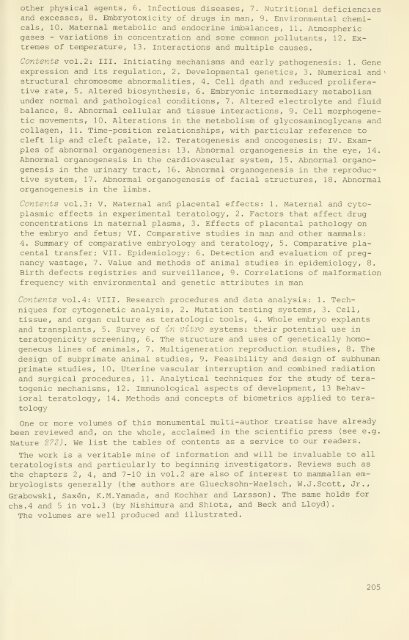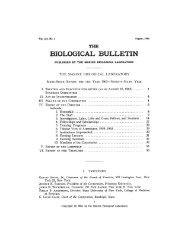General embryological information service - HPS Repository
General embryological information service - HPS Repository
General embryological information service - HPS Repository
You also want an ePaper? Increase the reach of your titles
YUMPU automatically turns print PDFs into web optimized ePapers that Google loves.
other physical agents, 6. Infectious diseases, 7. Nutritional deficiencies<br />
and excesses, 8. En±iryotoxicity of drugs in man, 9. Environmental chemicals,<br />
10. Maternal metabolic and endocrine imbalances, 11. Atmospheric<br />
gases - variations in concentration and some common pollutants, 12. Extremes<br />
of temperature, 13. Interactions and multiple causes.<br />
Contents vol.2: ill. initiating mechanisms and early pathogenesis: 1. Gene<br />
expression and its regulation, 2. Developmental genetics, 3. Numerical and<br />
structural chromosome abnormalities, 4. Cell death and reduced proliferative<br />
rate, 5. Altered biosynthesis, 5. Embryonic intermediary metabolism<br />
under normal and pathological conditions, 7. Altered electrolyte and fluid<br />
balance, 8. Abnormal cellular and tissue interactions, 9. Cell morphogenetic<br />
movements, 10. Alterations in the metabolism of glycosaminoglycans and<br />
collagen, 11. Time-position relationships, with particular reference to<br />
cleft lip and cleft palate, 12. Teratogenesis and oncogenesis; IV. Examples<br />
of abnormal organogenesis: 13. Abnormal organogenesis in the eye, 14.<br />
Abnormal organogenesis in the cardiovascular system, 15. Abnormal organogenesis<br />
in the urinary tract, 16. Abnormal organogenesis in the reproductive<br />
system, 17. Abnormal organogenesis of facial structures, 18. Abnormal<br />
organogenesis in the limbs.<br />
Contents vol.3: v. Maternal and placental effects: 1. Maternal and cytoplasmic<br />
effects in experimental teratology, 2. Factors that affect drug<br />
concentrations in maternal plasma, 3. Effects of placental pathology on<br />
the embryo and fetus; VI. Comparative studies in maxi and other mammals:<br />
4. Summary of comparative embryology and teratology, 5. Comparative placental<br />
transfer; VII. Epidemiology: 6. Detection and evaluation of pregnancy<br />
wastage, 7. Value and methods of animal studies- in epidemiology, 8.<br />
Birth defects registries and surveillance, 9. Correlations of malformation<br />
frequency with environmental and genetic attributes in man<br />
Contents vol.4: VIII. Research procedures and data analysis: 1. Techniques<br />
for cytogenetic analysis, 2. Mutation testing systems, 3. Cell,<br />
tissue, and organ culture as teratologic tools, 4. Whole embryo explants<br />
and transplants, 5. Survey of in vitvc systems: their potential use in<br />
teratogenicity screening, 6. The structure and uses of genetically homogeneous<br />
lines of animals, 7. Multigeneration reproduction studies, 8- The<br />
design of subprimate animal studies, 9. Feasibility and design of subhuman<br />
primate studies, 10. Uterine vascular interruption and combined radiation<br />
and surgical procedures, 11. Analytical techniques for the study of teratogenic<br />
mechanisms, 12. Immunological aspects of development, 13 Behavioral<br />
teratology, 14. Methods and concepts of biometrics applied to teratology<br />
One or more volumes of this monumental multi-author treatise have already<br />
been reviewed and, on the whole, acclaimed in the scientific press (see e.g.<br />
Nature 27d) . We list the tables of contents as a <strong>service</strong> to our readers.<br />
The work is a veritable mine of <strong>information</strong> and will be invaluable to all<br />
teratologists and particularly to beginning investigators. Reviews such as<br />
the chapters 2, 4, and 7-10 in vol.2 are also of interest to mammalian embryologists<br />
generally (the authors are Gluecksohn-Waelsch, W.J.Scott, Jr.,<br />
Grabowski, Saxen, K.M.Yamada, and Kochhar and Larsson) . The same holds for<br />
chs.4 and 5 in vol.3 (by Nishimura and Shiota, and Beck and Lloyd).<br />
The volumes are well produced and illustrated.<br />
205
















